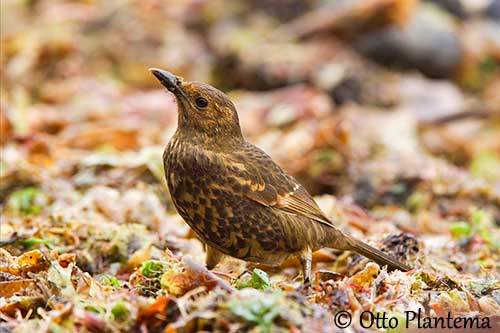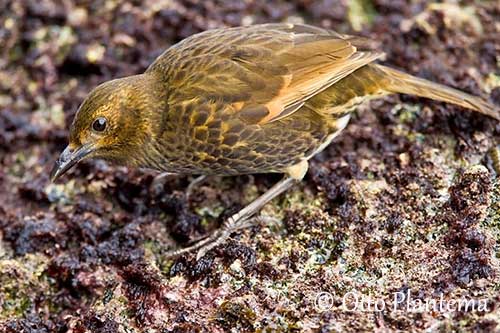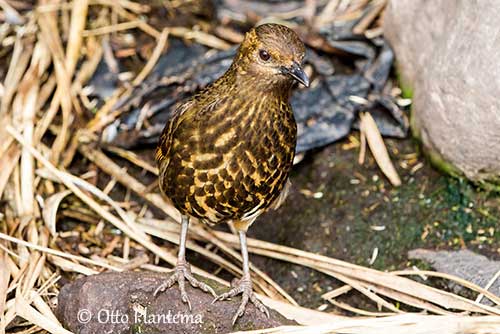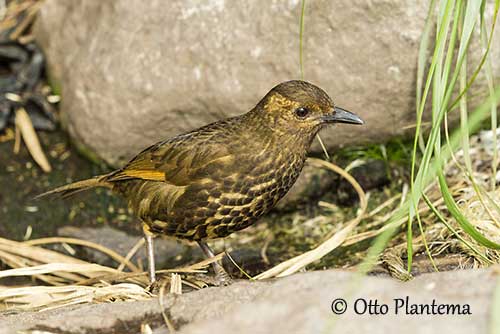
Fr: Grive de Tristan da Cunha
Ang: Tristan Thrush
All: Tristandrossel
Esp: Zorzal de Tristán da Cunha
Ita: Tordo di Tristan
Nd: Tristanlijster
Sd: Tristantrast
Photographer:
Otto Plantema
Trips around the world
Text by Nicole Bouglouan
Sources:
HANDBOOK OF THE BIRDS OF THE WORLD Vol 10 by Josep del Hoyo-Andrew Elliott-David Christie - Lynx Edicions - ISBN: 8487334725
THRUSHES by Peter Clement and Ren Hathway – HELM - ISBN: 0713639407
BirdLife International (BirdLife International)
Wikipedia, the free encyclopaedia
Bio One - Online Journals - Research Evolved
Tristan Thrush
Turdus eremita
Passeriformes Order – Turdidae Family
INTRODUCTION:
The Tristan Thrush is the only Turdidae in the Tristan da Cunha archipelago, and cannot be confused with any other species within its restricted range.
This thrush has probably evolved from a South American Turdidae. It is fairly similar to an immature Austral Thrush. However, this bird has adapted to its life on these small islands, and it has a brush-tipped tongue used for eating egg’s contents. The Tristan Thrush is known for feeding on seabirds’ eggs, being able to open large eggs like those of a small albatross. Several observations demonstrate this predatory behaviour.
DESCRIPTION OF THE BIRD:
Biometrics:
Length: 22-23 cm
Weight: 72-110 g
The adult of nominate race “eremita” has brown upperparts with crown, centre of mantle and back blotched dark brown to blackish. On the nape, the feathers are fringed slightly paler or browner. On the upperwing, we can see two narrow, orange-buff wingbars. The tail is brown, sometimes with paler edges.
On the underparts, the chin is pale buff whereas the throat is mottled or streaked dark brown. The breast is dark brown with pale orange-buff edged feathers forming a heavily mottled or streaked pattern on belly and flanks. Vent, thighs and undertail-coverts are pale orange-buff.
The large, strong bill is blackish with paler tip. The eyes are dark brown. Legs and feet are dusky to blackish-brown.
Both sexes are similar.
The juvenile resembles adult but it is darker above with pale buff spots and streaks. The breast is blackish with pale buff markings, whereas the belly is pale buff with blackish spots.

T.e. procax is found on Nightingale Island and adjacent Middle and Stoltenhoff Islands. This one is larger and darker, with darker orange underwing. The face is flecked or mottled pale brown on the ear-coverts.
HABITAT:
The Tristan Thrush frequents well-vegetated areas and can be seen in sheltered valleys, plantations, orchards, wet heath, scattered trees, grassy clearings, scrub, tree-fern tangles, dense tussock-grass areas and boulder-strewn slopes.
On Nightingale and Inaccessible islands, it forages along the beaches and also within penguin colonies.
On Inaccessible Island, is often enters seabird’s nesting burrows.
The nominate race “eremita” occurs mostly above 300 metres of elevation, and only reach low areas in severe winters.
CALLS AND SONGS: SOUNDS BY XENO-CANTO
The Tristan Thrush’s contact call is a rasping “chirp” given between pairs. The call is a soft whistle “seep”.
Like in most Turdidae species, the song is melodious, a rich, fluty series of phrases “chissik, chissik, chissik, trrkk” followed by repeated “swee swee swee”.
The Tristan Thrush sings from low perch within the canopy of tree or from the upper levels of Phylica arborea bush.
While calling, it frequently flicks the open wings.

REPRODUCTION OF THIS SPECIES:
The breeding season occurs between September and February.
The Tristan Thrush builds a cup-shaped nest with woven grass and tussock fronds, some green leaves and dead vegetation. It is lined with moss. This rough structure is placed on the ground or just above, usually at base of thick clump of vegetation, about 30 centimetres above the ground. It can be hidden under a rock or placed on a cliff ledge.
The female lays 2-3 greenish eggs with darker markings, 3 eggs in “procax” and 4 eggs in “gordoni”. The incubation is unknown, but probably lasts about two weeks. Both adults feed the chicks which fledge 20 days after hatching.
PROTECTION / THREATS / STATUS:
The Tristan Thrush is vulnerable to predation by Rattus rattus on Tristan da Cunha since feral cats have been eradicated.
This species has restricted range, and remains vulnerable to accidental introduction of predators on Nightingale and Inaccessible Islands which are predator-free.
Recently, the population of Tristan da Cunha was estimated at several hundreds birds. It is placed in the band 1500/7000 mature individuals, equating to 2500/9999 individuals.
But currently, the Tristan Thrush is classed as Near Threatened.
BEHAVIOUR IN THE WILD:
The Tristan Thrush is omnivorous. It forages on the ground in typical thrush-like manner, turning over leaves and moss in grassy areas and beneath trees. It also forages on the seashores. The usual food items are caterpillars, insects, ticks, snails, earthworms, seeds and berries. It can be seen scavenging from dead birds and fish, but this thrush is also known for its predatory behaviour against seabirds and other land birds, especially of genus “nesospiza”.
The strong bill allows the bird to open large eggs. The brush-tipped tongue is used to consume the contents of the eggs. But the Tristan Thrush also kills the chicks of petrel species by entering the nesting burrows from which it removes the small birds. It may also attack and kill storm-petrels, including adults.
The Tristan Thrush is usually seen alone or in pairs, sometimes in small loose groups, hopping and running on the ground.
Like other typical thrushes, it is territorial and monogamous. As a sedentary species, it probably maintains the territory all year round. Courtship feeding by male to female probably occurs, and the male may also perform mate-guarding while the female builds the nest.
It is sedentary and often seen on the ground, but it can fly.

SUBSPECIES AND RANGE:
Three subspecies are recognized.
T.e. eremita (described above) occurs on Tristan da Cunha.
T.e. gordoni (here displayed) is found on Inaccessible Island. This race is larger than nominate. It has cheeks, ear-coverts and supercilium paler and spotted or flecked light or warm brown. There is a pale buffish-brown submoustachial stripe and a darker brown malar stripe. The underparts are more spotted than streaked.
